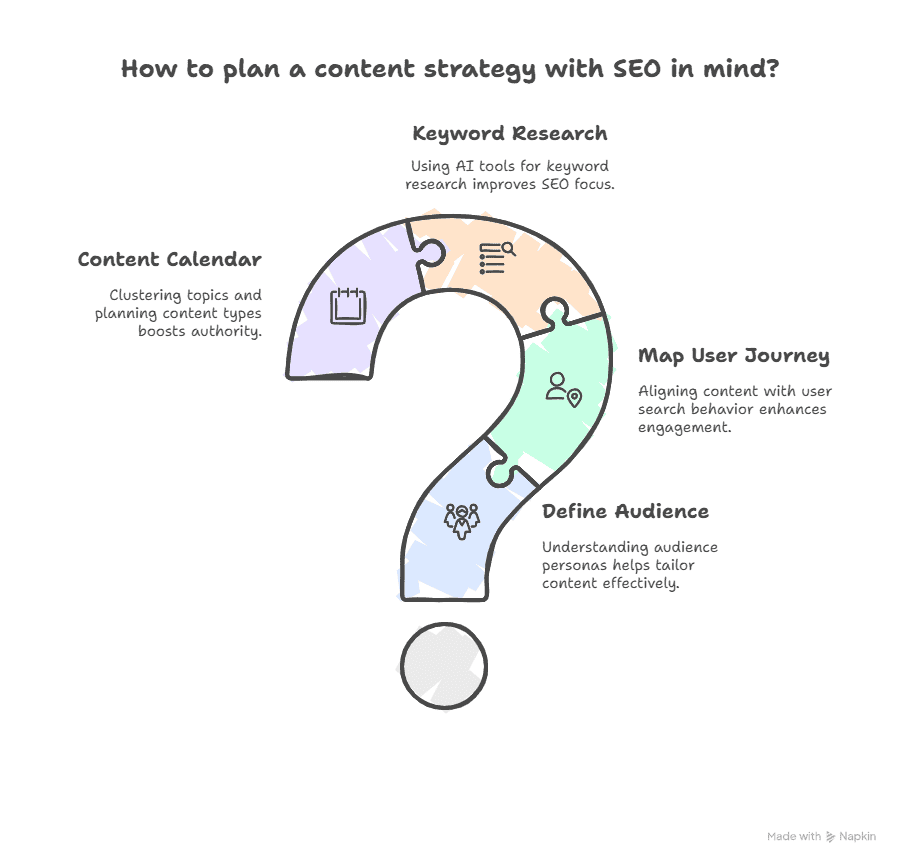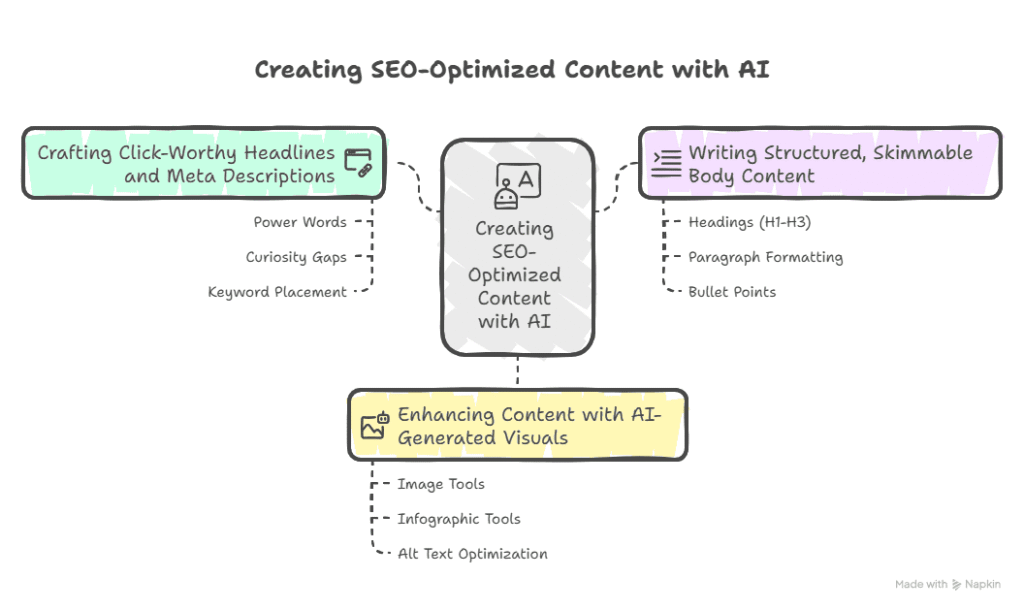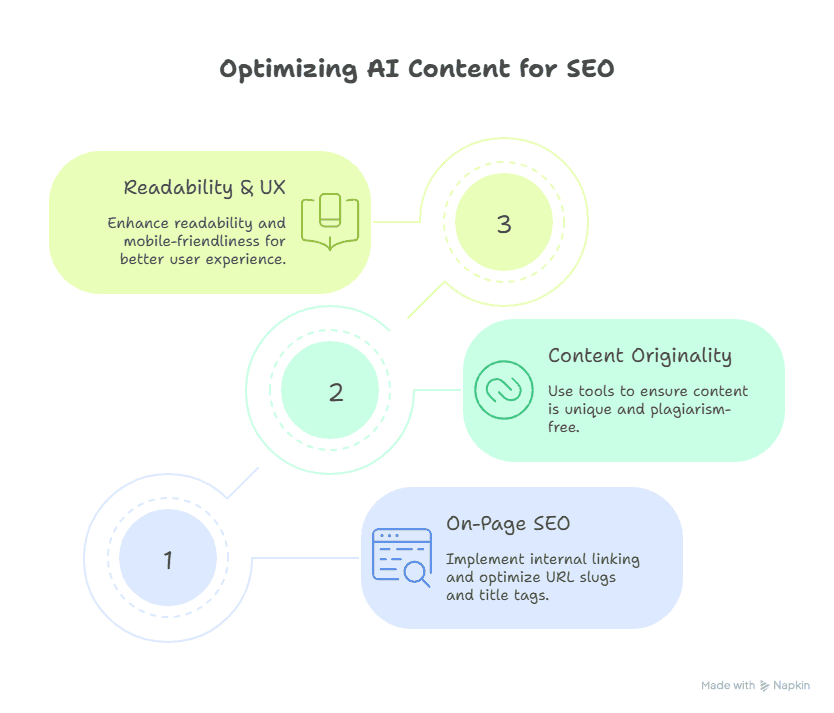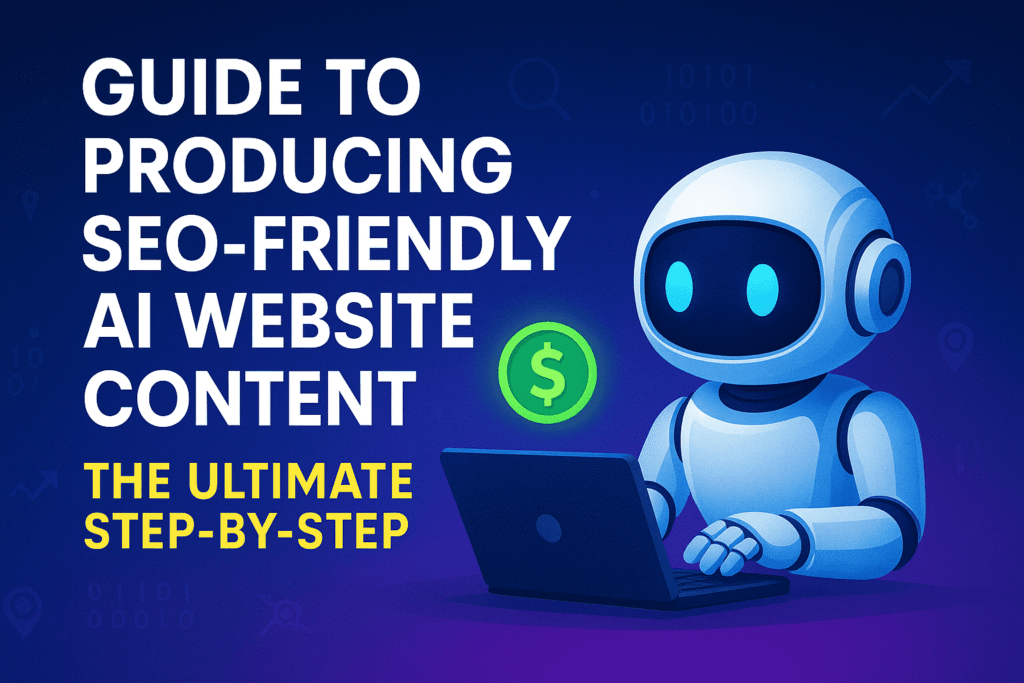Table of Contents
Love this post? Share it!
Introduction
Creating content today isn’t just about writing words—it’s about crafting experiences that are discoverable, valuable, and shareable. With the rise of artificial intelligence, the world of digital publishing is going through a massive transformation. If you’ve ever felt overwhelmed trying to keep up with SEO trends or struggled to produce high-quality content at scale, you’re not alone. But here’s the good news: AI is no longer a futuristic tool—it’s your right-hand assistant, ready to make your content smarter, faster, and more effective.
Whether you’re a solopreneur building your first website or a seasoned marketer looking to streamline your strategy, this guide will walk you through how to harness the power of AI to produce SEO-friendly content that performs. Let’s explore the perfect blend of technology and creativity that defines content creation in 2025.
Why SEO + AI Content Is the Future of Digital Publishing
The digital landscape is changing fast. Search engines are smarter, competition is fiercer, and audiences are craving more value-packed, relevant content than ever before. That’s where the synergy between SEO and AI comes in. SEO ensures your content gets found; AI helps you produce it at scale without sacrificing quality.
By using AI strategically, you can analyze data faster, generate content ideas in seconds, and automate repetitive tasks—all while aligning your work with SEO best practices. The result? Content that ranks higher, connects deeper, and converts better. AI isn’t here to replace human writers; it’s here to empower them with tools that enhance efficiency, accuracy, and creativity.
Who This Guide Is For
This guide is crafted especially for:
- Marketers who want to optimize their content production and stay ahead of algorithm updates.
- Bloggers seek consistency and speed without losing their authentic voice.
- Entrepreneurs building brand visibility and authority through organic content.
- Content creators are looking to scale their efforts across platforms with smart, SEO-rich assets.
If you wear any of these hats (or all of them!), this guide is your roadmap to working smarter—not harder.
What You’ll Learn from This Guide
Here’s a quick peek at what’s inside:
- The evolving definition of SEO and how AI fits into the picture
- How to identify your target audience and match content to search intent
- Practical keyword research strategies using AI tools
- How to create a seamless content calendar for consistent publishing
- Prompt engineering techniques that get better results from AI tools
- Tips to blend human creativity with AI-generated content for the best of both worlds
By the end, you’ll have a full-stack system for producing SEO-friendly AI content that brings traffic, builds trust, and grows your online presence.
Part 1: Foundations of SEO-Friendly AI Content
1.1 Understanding SEO in 2025 and Beyond
What Is SEO-Friendly Content?
SEO-friendly content is content designed not just for people, but also for search engines. It’s relevant, high-quality, easy to read, and structured in a way that search engines can understand. In 2025, it’s no longer just about stuffing keywords—it’s about satisfying search intent, using structured data, providing a great user experience, and building content around meaningful topics.
Why Search Intent Matters More Than Keywords
Search intent is the why behind a query. Is the user looking to learn something? Buy something? Compare products? Modern SEO goes beyond identifying keywords—it requires you to understand and fulfill what the user actually wants. AI tools can analyze this at scale, helping you align your content with what your audience is truly searching for, not just what they’re typing.
1.2 What Makes AI Content Different (and Powerful)
Strengths and Limitations of AI-Generated Content
AI content tools are incredibly fast. They can summarize, rephrase, generate outlines, or write complete blog posts in seconds. They’re excellent for drafting content, ideation, and filling in gaps. But AI still lacks emotional intelligence, nuance, and original thought. That’s where human input becomes essential—to refine, guide, and polish.
Ethical Guidelines and Google’s E-E-A-T Principles
AI-generated content must be ethical, factual, and valuable. Google’s E-E-A-T principles—Experience, Expertise, Authoritativeness, and Trustworthiness—are crucial. That means even when using AI, your content should reflect real-world knowledge, be backed by credible sources, and genuinely help the reader. AI should assist your expertise—not pretend to replace it.
Part 2: Planning Your Content Strategy with SEO in Mind

2.1 Define Your Audience and Their Search Intent
Audience Personas: Targeting the Right Readers
Before writing a single word, you need to know who you’re speaking to. Building detailed audience personas helps you craft content that resonates. Who are they? What are their pain points? Where do they hang out online? AI tools like ChatGPT can even help generate personas based on niche trends and analytics data.
How to Map Content to User Search Behavior
Once you understand your audience, you can map their journey—from awareness to decision-making. Create content that supports each step. For example, use blog posts for informational intent, comparison articles for consideration, and landing pages for transactional queries.
2.2 Keyword Research That Works with AI Tools
Finding Long-Tail and Semantic Keywords
Long-tail keywords are specific, lower-competition terms that reflect real user queries. They’re gold for AI content because they provide focus and intent. Semantic keywords—related terms and phrases—help build context, improve topic depth, and please search engines that rely on natural language processing.
Tools to Use: ChatGPT, SEMrush, Ubersuggest, SurferSEO
Use tools like:
- ChatGPT to brainstorm keyword ideas fast.
- SEMrush and Ubersuggest to validate search volume and competition.
- SurferSEO to analyze top-ranking pages and guide content structure.
Combining these tools streamlines your workflow and improves keyword strategy.
2.3 Creating a Winning Content Calendar
Cluster Topics Around Your Niche
Topical authority is key in SEO. Instead of random blog posts, cluster your content around central themes. For example, if your niche is digital marketing, create content silos like SEO, email marketing, and paid ads. This boosts authority and keeps readers engaged.
Planning Pillar vs. Supporting Content
Pillar content is long-form and comprehensive, covering a broad topic (e.g., “Complete Guide to Affiliate Marketing”). Supporting content dives into subtopics (e.g., “How to Choose Affiliate Programs”). AI can help generate outlines for both types, saving hours of manual planning.
Part 3: Setting Up the Right AI Content Workflow
3.1 Selecting the Best AI Writing Tools
Free vs Paid Tools: ChatGPT, Jasper, Copy.ai & More
There’s no shortage of AI writing tools out there. ChatGPT (free/Plus) is great for general use. Jasper excels in branded content. Copy.ai is perfect for quick marketing copy. Choose based on your budget, content goals, and desired level of control.
How to Choose Based on Your Business Goals
- Want speed? Go with tools that generate long-form content fast.
- Need quality? Prioritize tools with fact-checking or editing features.
- Tight on budget? Combine free tools with manual effort to get results.
3.2 Structuring Prompts for High-Quality Outputs
Prompt Engineering 101: Giving AI the Right Instructions
Your results are only as good as your prompts. Be specific. Provide format, tone, length, and purpose. For example: “Write a 100-word intro for a blog post about SEO tools for beginners in a friendly tone.”
Examples of Good vs Bad Prompts
- ❌ Bad: “Write about SEO.”
- ✅ Good: “Write a list of 5 beginner-friendly SEO tools with brief pros and cons for each, targeting small business owners.”
The more detailed your prompt, the better the output.
3.3 Blending Human Creativity and AI Efficiency
When to Use AI and When to Write Manually
Use AI for:
- Outlining
- Research summaries
- First drafts
Write manually when: - Telling personal stories
- Injecting opinions or experiences
- Needing nuanced arguments
Adding Human Touch: Empathy, Humor, and Authority
AI can write fast, but it can’t feel. Your human touch—empathy, humor, experience—is what makes content memorable. Always review AI content and add layers of personality and credibility to build trust with your readers.
Part 4: Creating SEO-Optimized Content with AI

4.1 Crafting Click-Worthy Headlines and Meta Descriptions
Power Words, Curiosity Gaps, and Keyword Placement
A strong headline does more than attract attention—it drives clicks, which in turn can boost your SEO rankings. To create headlines that stand out, use power words like “ultimate,” “essential,” “proven,” or “step-by-step.” Combine those with a curiosity gap that makes readers want to learn more, such as: “You Won’t Believe These Simple SEO Tricks That Actually Work.”
Don’t forget keyword placement—your primary keyword should appear naturally within your headline and meta description. This helps search engines understand your topic and improves visibility in SERPs.
How AI Can Help Write Metadata in Seconds
AI tools like ChatGPT, Jasper, or Writesonic can generate dozens of headline variations and meta descriptions instantly. You simply provide the focus keyword and a brief prompt. For example:
Prompt: “Write five catchy blog titles for a post about SEO tools for beginners.”
You’ll get back options that are keyword-rich, emotionally engaging, and ready to test. Even better, you can run A/B tests using different AI-generated titles to see what performs best.
4.2 Writing Structured, Skimmable Body Content
Using Headings (H1-H3) for SEO and Readability
Headings serve two vital functions: they help readers scan your content quickly and help search engines understand your page structure. Use H1 for your main title, H2s for main sections, and H3s for supporting points under each H2.
AI tools can help generate structured outlines with headings automatically. You can prompt ChatGPT with:
“Give me an outline for a blog post about affiliate marketing with H2 and H3 tags.”
This not only saves time but ensures logical flow and clarity.
Paragraph Formatting, Bullet Points, and Content Flow
Keep paragraphs short—2 to 4 sentences is ideal. Break up long blocks of text with bullet points, bold text, and callout boxes to improve scannability. AI often writes in large blocks, so take time to review and format the content properly.
When using bullet points:
- Keep each point concise
- Start with a verb when possible
- Use consistent formatting
This makes your content easier to digest and more engaging for time-pressed readers.
4.3 Enhancing Content with AI-Generated Visuals
Tools for Images, Infographics, and Thumbnails
Visuals don’t just enhance the user experience—they improve dwell time, social sharing, and even SEO (when optimized). AI-powered tools like Canva, Visme, Designs.ai, and DALL·E allow you to create:
- Featured images and blog thumbnails
- Data-driven infographics
- Custom illustrations and charts
You can even use AI to generate unique concept visuals based on text prompts, giving your content a fresh and branded look.
Alt Text and Image SEO Optimization
Every image should include alt text that describes the image clearly and includes relevant keywords (where appropriate). Alt text helps with:
- SEO ranking
- Accessibility for screen readers
- Content comprehension when images fail to load
AI can help write alt text at scale, especially if you feed it a clear description and keyword guidance.
Part 5: Optimizing AI Content for Search Engines
5.1 On-Page SEO Best Practices

Internal Linking and Anchor Text Strategy
Internal links help guide users to related pages and signal to search engines how your content is connected. Use descriptive anchor text that reflects the content of the page it links to. Avoid generic phrases like “click here” or “read more.”
Good example: Learn more about long-tail keyword research.
AI can help identify relevant pages to link internally based on keyword matching.
URL Slugs, Title Tags, and Content Length Guidelines
- URL Slugs: Keep them short, lowercase, and keyword-rich. Ex: yourdomain.com/seo-content-ai
- Title Tags: Aim for 55–60 characters, include your target keyword, and make it compelling.
- Content Length: While there’s no magic word count, aim for depth. Most top-ranking pages are 1,500–2,500+ words. AI can help you hit those targets faster.
5.2 Ensuring Content Originality and Plagiarism-Free Text
Tools to Check Originality: Grammarly, Copyscape, Originality.ai
Even though AI generates unique combinations of words, it’s still smart to verify originality. Use:
- Grammarly Premium for plagiarism scans and readability checks
- Copyscape to scan the web for duplicates
- Originality.ai (built specifically for AI detection)
This is especially important if you’re publishing content frequently or outsourcing AI writing.
How to Rewrite AI Text to Add Uniqueness
Want to stand out? Add:
- Real-life examples or personal insights
- Updated statistics or quotes from recent sources
- Brand-specific language and tone
AI gives you the bones—you provide the voice and soul.
5.3 Improving Readability and UX
Flesch Scores, Mobile-Friendliness, and Visual Layout
Readability affects bounce rate, time on page, and SEO. Use tools like Hemingway Editor or Yoast SEO to check your Flesch Reading Ease score. Aim for a score of 60–70 (plain English).
Mobile-first design is non-negotiable. Make sure your font size, line spacing, and layout look great on all screen sizes. AI can help simulate mobile previews or generate mobile-optimized summaries.
How UX Impacts Bounce Rate and Rankings
When users can find what they need quickly, they stay longer. That signals to search engines that your page is valuable. A clean layout, logical flow, internal links, and fast loading speeds all contribute to better user experience—and better rankings.
Part 6: Publishing and Promoting AI SEO Content
6.1 Content Management and Blog Platforms
WordPress, Webflow, Ghost – Which One to Use?
- WordPress is the most flexible and widely supported, perfect for SEO plugins and customizations.
- Webflow offers beautiful visual design with clean code.
- Ghost is minimal and fast, great for focused blogging and publishing.
Choose based on your goals: SEO power (WordPress), visual branding (Webflow), or speed/simple blogging (Ghost).
How to Set Up SEO Plugins and Tools
On WordPress, use:
- Yoast SEO or Rank Math for on-page optimization
- WP Rocket or LiteSpeed Cache for performance
- Google Site Kit for tracking metrics
These tools guide you through every step, from meta tags to sitemap generation.
6.2 Promoting Content Through Multiple Channels
Email Marketing, Pinterest, Facebook, LinkedIn, Reddit
AI-written content doesn’t promote itself. Share across platforms:
- Email: Send weekly roundups or tips using AI-curated excerpts
- Pinterest: Create pin graphics linking back to blog posts
- Facebook/LinkedIn: Repurpose snippets into social posts or carousels
- Reddit: Answer niche questions with a helpful tone and link to your blog where relevant
How to Repurpose AI Content into Shorts, Pins, and Newsletters
One blog post can become:
- A carousel on Instagram
- A Pinterest infographic
- A LinkedIn article
- A short YouTube script or TikTok talking point
- A lead magnet in your email funnel
Use AI to rephrase and restructure the content to fit each format effortlessly.
6.3 Monitoring Content Performance and Rankings
Google Search Console and Analytics
Use Google Search Console to track impressions, clicks, and rankings. It helps you spot:
- Which keywords are driving traffic
- Pages with low CTRs
- Opportunities for on-page improvement
Combine it with Google Analytics to monitor bounce rate, average session time, and user journeys.
KPIs to Watch: CTR, Engagement Time, Bounce Rate
Track:
- CTR (Click-Through Rate): Measures headline/meta performance
- Time on Page: Indicates content engagement
- Bounce Rate: High bounce? Might need better UX or content flow
These insights guide future content updates and optimization.
Conclusion
Final Thoughts: Merging Strategy and Smart Automation
AI is transforming how we produce content—but strategy still reigns supreme. When you combine the speed of AI with the creativity and empathy of human writers, you create powerful, SEO-optimized content that ranks well and resonates deeply.
The future of content isn’t man vs. machine—it’s man with machine. By learning how to guide AI effectively and optimize its outputs, you unlock a whole new level of efficiency and growth.
How to Stay Ahead in SEO with AI
Stay updated on algorithm changes, test new tools, and never stop learning. AI evolves fast—but so do you. Continue refining your workflows, experimenting with content types, and focusing on what truly matters: helping your audience.
FAQs
Q1: Can Google detect AI-generated content?
Yes, but what matters is quality, originality, and user value. Follow Google’s E-E-A-T guidelines and always review your content.
Q2: Is AI-generated content good for SEO?
Absolutely—when it’s optimized correctly and enhanced with human editing. AI saves time, and SEO ensures visibility.
Q3: How do I prompt AI to write long-form blog posts?
Use detailed prompts with structure, tone, and purpose. Break it into sections for clarity and control.
Q4: What tools do I need to produce AI SEO content?
ChatGPT or Jasper for writing, SurferSEO for optimization, Grammarly for clarity, and Google Search Console for tracking.
Q5: How often should I update AI-written blog content?
Review and refresh content every 3–6 months to stay aligned with trends, keyword shifts, and Google updates.

